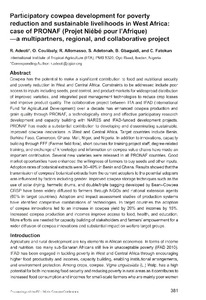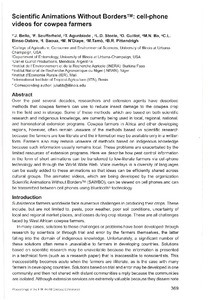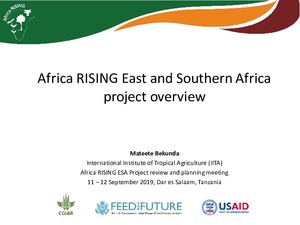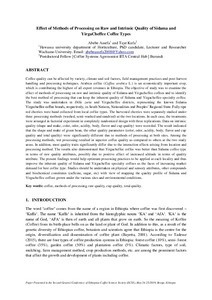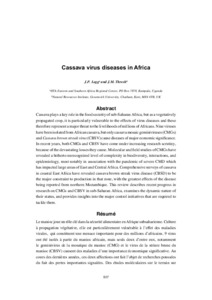Welcome to the International Institute of Tropical Agriculture Research Repository
Conference Documents: Recent submissions
Now showing items 21-40 of 727
-
Gender and access to cowpea innovations in West Africa: a review of some critical issues
(International Institute of Tropical Agriculture, 2012)Cowpea provides food and incomes to farm households including women farmers who make and sell snack foods from this nutritious legume in West Africa. Gender roles are important in cowpea value chains. The main constraints reported by women are poor access to cowpea innovations, opportunities, and related capacity building. The overall objective of this paper is to review key constraints and opportunities for an effective inclusion of women in cowpea value chains through access to innovations using ... -
Participatory cowpea development for poverty reduction and sustainable livelihoods in west Africa: case of PRONAF (Projet Niebe pour l'Afrique)- a multipartners, regional, and collaborative project
(International Institute of Tropical Agriculture, 2012)Cowpea has the potential to make a significant contribution to food and nutritional security and poverty reduction in West and Central Africa. Constraints to be addressed include poor access to inputs including seeds, pest control, and product markets for widespread distribution of improved varieties, and integrated pest management technologies to reduce crop losses and improve product quality. The collaborative project between IITA and IFAD (International Fund for Agricultural Development) over ... -
Scientific animations without borders: cell-phone videos for cowpea farmers
(International Institute of Tropical Agriculture, 2012)Over the past several decades, researchers and extension agents have described methods that cowpea farmers can use to reduce insect damage to the cowpea crop in the field and in storage. Some of these methods, which are based on both scientific research and indigenous knowledge, are currently being used in local, regional , national, and transnational extension programs. Cowpea farmers in Africa and other developing regions, however, often remain unaware of the methods based on scientific research ... -
Africa RISING east and southern Africa project overview
(Africa RISING, 2019) -
Effect of methods of processing on raw and intrinsic quality of Sidama and YirgaCheffee coffee types
(Ethiopian Coffee Science Society, 2019)Coffee quality can be affected by variety, climate and soil factors, field management practices and post-harvest handling and processing techniques. Arabica coffee (Coffea arabica L.) is an economically important crop, which is contributing the highest of all export revenues in Ethiopia. The objective of study was to examine the effect of methods of processing on raw and intrinsic quality of Sidama and Yirgacheffee coffees and to identify the best method of processing that can keep the inherent ... -
Challenges, opportunities and strategy for cassava subsector development in Nigeria
(2003)Nigeria has substantial economic potential in its agricultural sector. However, despite the importance of agriculture in terms of employment creation, its potential for contributing to economic growth is far from being fully exploited. The sector’s importance fluctuates with any rise and fall in oil revenue and has remained stagnant over the past ten years. The contribution of the manufacturing sector to the GDP declined over the same period. Inappropriate macroeconomic and sector policies perpetuated ... -
Cassava virus diseases in Africa
(2003)Cassava plays a key role in the food security of sub-Saharan Africa, but as a vegetatively propagated crop, it is particularly vulnerable to the effects of virus diseases and these therefore represent a major threat to the livelihoods of millions of Africans. Nine viruses have been isolated from African cassava, but only cassava mosaic geminiviruses (CMGs) and Cassava brown streak virus (CBSV) cause diseases of major economic signifi cance. In recent years, both CMGs and CBSV have come under ... -
Evaluation de nouvelles varieties digname en Cote dIvoire: bilan de trois annees dexperience avec des genotypes ameliores par lIITA
(2003)Assessment of new yam varieties in Côte d’Ivoire : results of three experiments years with improved genotypes by IITA The most important food crop in the Ivory Coast, yam, is cultivated in a traditional system with low productivity. In order to suffice the needs of the growing population the introduction of new technologies increasing the production of yam is mandatory. One way suggested here is the introduction of new improved varieties. The aim of this project was to identify promising varieties ... -
Amelioration de la production de ligname a travers la fertilisation minerale en zone de savene de Cote dIvoire
(2003)Improving yam production by mineral fertilisation in the savanna zone of Cote d’Ivoire. Côte d’Ivoire is the second producer of yam after Nigeria with 2.8 millions tons produced per year. Though its farmers are still looking for ‘’virgin’’ soil to increase their yields. Mineral fertilization study led in the savanna zone has as objective to determine the response of local yams to mineral fertilizers. Thus, four local varieties (Bètè bètè, Gnan, Krenglè and Wacrou) are tested with two fertility ... -
Explaining the Failure in Agricultural production in subSaharan Africa
(2003)This paper examines changes in agricultural productivity in 10 Subsaharan countries. The relative performance of agricultural sector was gauged using data envelopment analysis. From a panel data set of the 10 countries which included the 28-year period 1972-1999, mathematical programming methods were used to measure Malmquist indexes of total factor productivity. It was found that, during that period, total factor productivity have experienced a negative evolution in sample countries. A decomposition ... -
Advances in yam and cassava nematology research at IITA
(2003)Progress in pest management on cassava (Manihot esculenta) in Africa has witnessed remarkable achievements over recent years in the management of African cassava mosaic virus, cassava mealy bug, cassava green mite and overall germplasm improvement for yield improvements. From the scant information available, root-knot nematodes appear to pose potentially serious constraints to cassava production across Africa. Under heavy infection, 98 % yield losses have been reported and in a survey in Uganda, ... -
Economic gains from maize research in West and Central Africa: an overview
(2003)Agricultural research by national systems and international institutes has contributed to the increase in maize production and productivity in West and Central Africa (WCA) over the last three decades. This subregion accounted for about 43% of maize production in sub-Saharan Africa (SSA) from 1998-2000, compared with 17% 30 years ago (1968-1970). Yields improved by 41% from an average of 858 kg ha"' in 1970 to about 1210 kg ha"' in 2000. During the period under review, a large number of disease ... -
The role of GIS in the development and targeting of maize germplasm to farmers in West and Central Africa
(2003)Maize (Zea mays L) is cultivated under a broad range of climatic conditions in West and Central Africa (WCA). For the purpose of germplasm evaluation, maize researchers in the subregion loosely stratified the diverse environments into four agroecological zones based on their knowledge and experience rather than on quantitative studies involving climatic data. Recent advances in the development of digital spatial databases and geographic information systems (GIS) have provided unprecedented ... -
Plant virology in subSaharan Africa: proceedings of a conference organized by IITA, 48 June 2001
(2003)The rice yellow mottle diseases is the main virus disease found on rice in Africa. It has been reported in all major rice producing zone of sub-saharan Africa (East,West,Central and Southern Africa and Madagascar). The disease incidence and accompanying yield losses could be high depending on the rice cultivars grown, the date of infection and type of rice. -
Use of Alternaria eichhorniae to control the invasive aquatic weed water hyacinth in Africa
(2003)Water hyacinth has been given the dubious honour by the UN of the world’s most troublesome weed. Since its introduction as an ornamental it has attained a pan- African distribution. It prevents transport, fishing, commerce, the generation of hydroelectricity and increases incidences of malaria, bilharzia, filariasis and encephalitis. We are studying the potential of using a fungal pathogen as an environmentally friendly method of control. Field surveys and laboratory tests have identified those ...


